Physics for Electrical Engineering: Unit II: b. Magnetic Properties of Materials
Exchange Interaction and Ferromagnetism
Magnetic Properties of Materials
The ferromagnetic property is exhibited by transition elements such as iron, cobalt, and nickel at room temperature and rare earth elements like gadolinium and dysprosium.
EXCHANGE
INTERACTION AND FERROMAGNETISM
The
ferromagnetic property is exhibited by transition elements such as iron,
cobalt, and nickel at room temperature and rare earth elements like gadolinium
and dysprosium.
The
ferromagnetic materials possess parallel alignment of dipoles. This parallel
alignment of dipoles is not due to the magnetic force existing between any two
dipoles. The reason is that the magnetic potential energy is very small and it
is smaller than thermal energy.
The
electronic configuration of iron is 1s2, 2s2, 2p6,
3s2,3p6,3d6, 4s2. For iron, the 3d
subshell is an unfilled one. This 3d subshell have five orbitals.
For
iron, the six electrons present in the 3d subshell occupy the orbitals such
that there are four unpaired electrons and two paired electrons as shown in
figure 2.28.
These
four unpaired electrons contribute a magnetic moment of 4ẞ. This arrangement
shows the parallel alignment of four unpaired electrons.
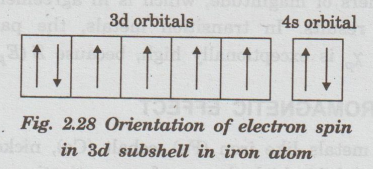
The
parallel alignment of dipoles in iron is not due to the magnetic interaction. It
is due to the Pauli's exclusion principle and electrostatic interaction energy.
The Pauli's exclusion principle and
electrostatic interaction energy are combined together and constitute a new
kind of interaction known as exchange interaction. The exchange interaction is
a quantum mechanical concept.
The
exchange interaction between any two atoms depends upon the interatomic
separation between the two interacting atoms and the relative spins of the two
outer electrons. The exchange interaction between any two atoms is given by
Eex=
- Je S1 S2
where
Je is the numerical value of the exchange integral,S1 and
S2 are the spin angular momenta of the first and second electrons.
The
exchage integral value is negative for a number of elements. Therefore, the
exchange energy value is negative (minimum energy configuration) when the spin
angular momentum S1 and S2 are opposite direction.
Hence,
antiparallel alignment of dipole is favoured. This explains the antiparallel
alignment of dipoles in antiferromagnetic materials.
In
some materials like iron, cobalt and nickel the exchange integral value is
positive. The exchange energy is negative when the spin angular momentum is in
the same direction. This will produce a parallel alignment of dipoles.
A plot between the exchange integral and the
ratio of the interatomic separation to the radius of 3d orbital (r/rd)
is shown in figure 2.29.
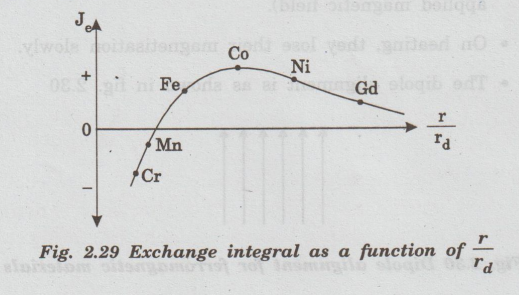
For
the transition metals like iron, cobalt, nickel and gadolinium the exchange
integral is positive, whereas for manganese and chromium the exchange integral
is negative.
The
positive value of the exchange integral represents the material as
ferromagnetic and the negative exchange integral value represents the material
as antiferromagnetic.
In
general, if the ratio, r/rd >3, the material is ferromagnetic,
otherwise the material is antiferromagnetic. It should be noted that manganese
is suitably alloyed so that r/rd> 3, and it will become
ferromagnetic.
Ferromagnetic materials
The materials which exhibit the ferromagnetism
are called ferromagnetic materials.
Properties
•
All the dipoles are aligned parallel to each other due to the magnetic
interaction between the dipoles.
•They
have permanent dipole moment. They are strongly attracted by the magnetic
field.
•
They exhibit magnetisation even in the absence of magnetic field. This property
of ferromagnetic materials is called as spontaneous
magnetisation.
•
They exhibit hysteresis (lagging of magnetisation with applied magnetic field).
•
On heating, they lose their magnetisation slowly.
•
The dipole alignment is as shown in fig. 2.30
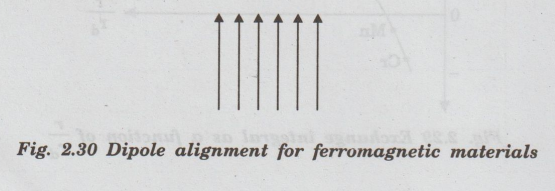
•
The magnetic susceptibility is very high and it depends iston temperature.
It
is given by
Χ
= C / T-θ (for T > θ, paramagnetic behaviour T < θ, ferromagnetic
behaviour)
where
C is Curie constant and θ ferromagnetic Curie temperature.
Table 2.1
Comparison of Dia, Para and
Ferro-magnetic Materials
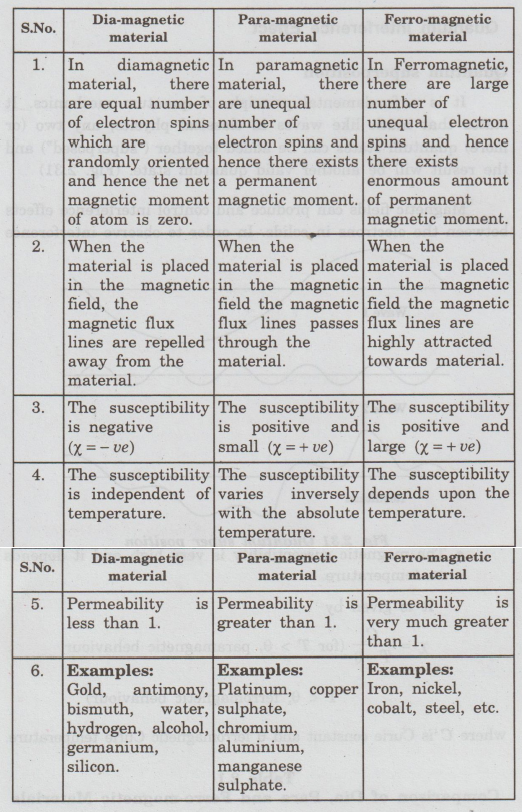
Quantum Interference Effect
Quantum superposition
It
is a fundamental principle of quantum mechanics. It states that much like waves
in classical physics, any two (or more) quantum states can be added together
("superposed") and the result will be another valid quantum state.
(Fig. 2.31)
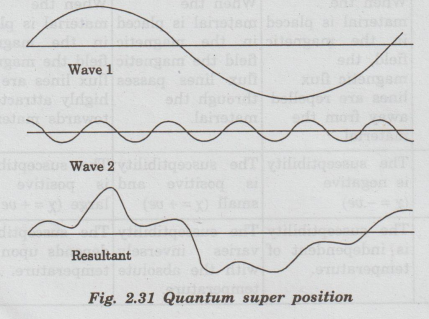
Magnetic
fields can produce and control interference effects between the electrons in
solids. In order to observe interference effects between different electron
waves, their phase has to be maintained.
The
phase coherence length Lϕ is the distance travelled by an electron
without changing its phase. The phase of an electron wave is generally
destroyed when electrons interact inelastically with defects in the lattice.
In general, ballistic electrons
with a mean free path le much larger than sample dimensions L, (i.e.le
>> L,) travel through the lattice without scattering. Therefore they show
interference effects.
Applications of Quantum
Interference Effect
Quantum
interference effect is being applied in a growing number of applications, such
as the
•
Superconducting Quantum Interference Device (SQUID).
•
quantum cryptography
•
quantum computing and quantum interference transistor.
Physics for Electrical Engineering: Unit II: b. Magnetic Properties of Materials : Tag: : Magnetic Properties of Materials - Exchange Interaction and Ferromagnetism
Related Topics
Related Subjects
Physics for Electrical Engineering
PH3202 2nd Semester 2021 Regulation | 2nd Semester EEE Dept 2021 Regulation
